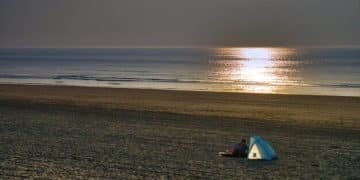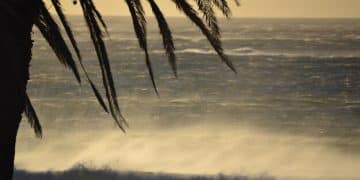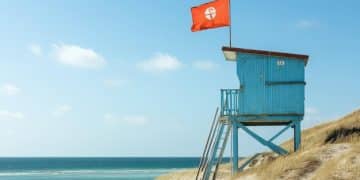Master the Beach: A Guide to Reading Tides, Currents, and Waves
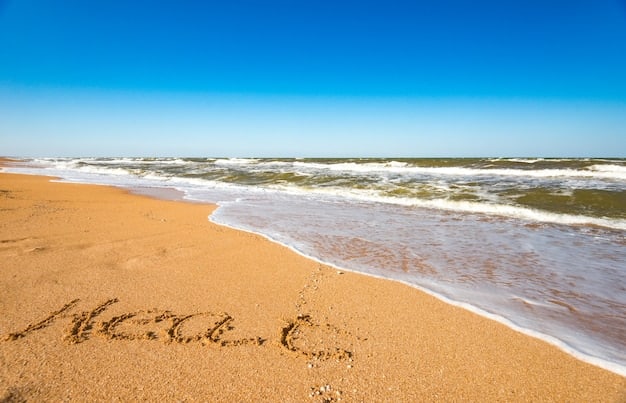
Understanding how to read beach conditions, including tides, currents, and wave patterns, is crucial for ensuring safety and enhancing enjoyment during beach activities and water sports. This involves recognizing visual cues, interpreting weather forecasts, and understanding the dynamic interplay of natural forces that shape the coastal environment.
Heading to the beach? Before you dive in, it’s essential to understand the language of the ocean. Learning how to read beach conditions: a guide to understanding tides, currents, and wave patterns can transform your beach experience from risky to relaxing.
Understanding Tides: The Rhythmic Breath of the Ocean
Tides, the rhythmic rise and fall of sea levels, are a fundamental aspect of beach conditions. Understanding tides is crucial for planning activities, ensuring safety, and appreciating the dynamic nature of the coastal environment.
Tidal patterns are primarily influenced by the gravitational forces of the moon and, to a lesser extent, the sun. These forces create bulges of water on opposite sides of the Earth, resulting in predictable cycles of high and low tides.
Types of Tides
There are three main types of tidal patterns, each characterized by distinct cycles and heights:
- Diurnal Tides: Featuring one high tide and one low tide each day, diurnal tides are common in regions like the Gulf of Mexico.
- Semidiurnal Tides: Exhibiting two high tides and two low tides of approximately equal height each day, semidiurnal tides are prevalent along the Atlantic coasts.
- Mixed Tides: Presenting two high tides and two low tides of varying heights each day, mixed tides are often observed along the Pacific coasts.
Factors Affecting Tides
Several factors beyond lunar and solar gravity can influence tidal patterns. Coastal geography, weather conditions, and seasonal variations all play a role.
- Coastal Geography: The shape of coastlines and the depth of coastal waters can amplify or dampen tidal ranges. Narrow inlets and estuaries often experience higher tidal ranges than open coastlines.
- Weather Conditions: Storm surges, caused by strong winds and low atmospheric pressure, can significantly elevate sea levels, leading to abnormally high tides and coastal flooding.
- Seasonal Variations: The Earth’s elliptical orbit around the sun affects tidal ranges throughout the year. Spring tides, characterized by higher high tides and lower low tides, occur during the new and full moon phases, while neap tides, with smaller tidal ranges, occur during the first and third quarter moon phases.
Understanding tides enables beachgoers to plan activities around optimal conditions, avoid hazards associated with changing water levels, and appreciate the natural rhythms of the ocean. Whether you’re swimming, surfing, or simply strolling along the shore, knowledge of tides enhances your beach experience.
Decoding Currents: Navigating the Ocean’s Highways
Currents are streams of water moving horizontally through the ocean, and understanding them is vital for safe and enjoyable beach activities. Currents can significantly impact swimming conditions, navigation, and coastal erosion.
Ocean currents are driven by various factors, including wind, temperature differences, salinity variations, and the Earth’s rotation. These forces create a complex network of currents that influence weather patterns, nutrient distribution, and marine life migration.

Types of Currents
Various types of currents affect beaches, each with unique characteristics and potential hazards:
- Rip Currents: Strong, narrow currents flowing away from the shore, rip currents can quickly carry swimmers out to sea. They are often identifiable by a break in the wave pattern or a channel of murky water.
- Longshore Currents: Currents flowing parallel to the shoreline, longshore currents are created by waves approaching the beach at an angle. They can transport swimmers and objects down the beach, making it challenging to return to a specific location.
- Undertows: Although often misunderstood, undertows are the return flow of water after a wave breaks on the shore. While not as dangerous as rip currents, they can still knock swimmers off their feet and pull them towards the ocean floor.
Recognizing and Avoiding Dangerous Currents
Identifying and avoiding dangerous currents is crucial for beach safety. Here are some tips for staying safe in the water:
- Swim in Designated Areas: Lifeguarded beaches are the safest option, as lifeguards are trained to identify and respond to dangerous currents.
- Look for Warning Signs: Pay attention to posted signs and flags indicating potential hazards, such as rip currents or strong surf.
- Observe the Water: Look for signs of rip currents, such as breaks in the wave pattern, channels of murky water, or debris moving offshore.
- If Caught in a Rip Current: Don’t panic and don’t swim against the current. Swim parallel to the shore until you are out of the current, then swim back to the beach at an angle.
By understanding the dynamics of ocean currents, beachgoers can make informed decisions about where and how to swim, increasing their safety and enjoyment of the beach environment. Whether you’re a seasoned surfer or a casual swimmer, awareness of currents is essential for a positive beach experience.
Wave Patterns: Reading the Language of the Waves
Wave patterns are another crucial element of beach conditions, influencing everything from surf conditions to coastal erosion. Understanding wave patterns allows beachgoers to anticipate changes in the surf, identify potential hazards, and appreciate the power and beauty of the ocean.
Waves are generated by wind blowing across the surface of the water. The size and shape of waves depend on the wind speed, the duration of the wind, and the distance over which the wind blows (fetch). As waves approach the shore, they interact with the ocean floor, causing them to slow down, steepen, and eventually break.
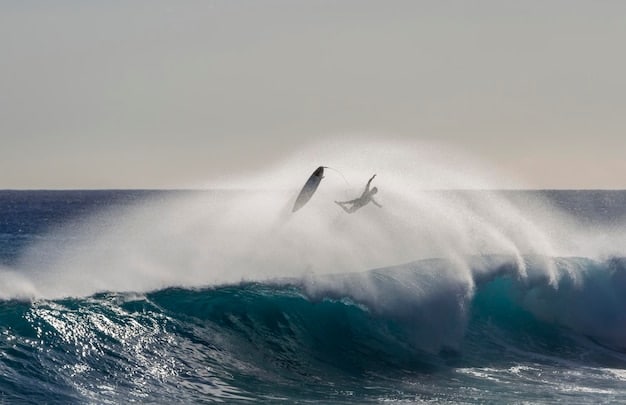
Factors Influencing Wave Patterns
Several factors influence wave patterns, including:
- Wind Speed and Direction: Stronger winds create larger waves, while the direction of the wind determines the angle at which waves approach the shore.
- Fetch: The distance over which the wind blows uninterruptedly affects the size of waves. Longer fetches result in larger waves.
- Ocean Floor Topography: The shape and depth of the ocean floor influence how waves break. Shallow areas tend to produce steeper, more powerful waves, while deeper areas result in gentler, more gradual waves.
Types of Waves
Waves come in various forms, each with distinct characteristics and implications for beach activities:
- Surge Waves: Characterized by a long period and low amplitude, surge waves are common in sheltered areas and often create gentle surf conditions.
- Spilling Waves: Occurring on gently sloping beaches, spilling waves break gradually, with foam cascading down the front of the wave. They are ideal for beginner surfers and swimmers.
- Plunging Waves: Forming on steeper beaches, plunging waves break suddenly, with the crest of the wave curling over and crashing down. They are popular among experienced surfers but can be dangerous for swimmers.
By observing wave patterns, beachgoers can assess the surf conditions and make informed decisions about whether to swim, surf, or simply relax on the beach. Understanding the language of the waves enhances appreciation for the ocean’s power and its potential hazards.
Utilizing Weather Forecasts: Predicting Beach Conditions
Weather forecasts are invaluable tools for predicting beach conditions, providing insights into wind speed, wave height, water temperature, and potential hazards. By consulting weather forecasts, beachgoers can plan their trips accordingly and make informed decisions about safety and enjoyment.
Many resources offer detailed weather forecasts for coastal areas, including:
- National Weather Service (NWS): The NWS provides comprehensive weather forecasts for the United States, including marine forecasts specifically tailored to coastal regions.
- Local News Outlets: Local television and radio stations often provide weather forecasts focused on specific beach areas.
- Online Weather Websites and Apps: Numerous websites and mobile apps, such as Weather Underground, AccuWeather, and Windy, offer detailed weather forecasts, including wave height, wind speed, and water temperature.
Interpreting Weather Forecasts
Learning how to interpret weather forecasts is essential for accurately predicting beach conditions. Here are some key factors to consider:
- Wind Speed and Direction: Strong winds can create choppy water and larger waves, making it more challenging to swim or surf. Offshore winds (blowing from the land towards the sea) can create smoother surf conditions, while onshore winds (blowing from the sea towards the land) can create rougher conditions.
- Wave Height and Period: Wave height indicates the size of the waves, while wave period refers to the time between successive wave crests. Longer wave periods generally indicate more powerful surf.
- Water Temperature: Water temperature affects swimming comfort and can also indicate the presence of certain marine life.
- Tide Information: Weather forecasts often include tide information, allowing beachgoers to plan activities around high or low tide.
Limitations of Weather Forecasts
While weather forecasts are valuable tools, it’s essential to remember that they are not always perfectly accurate. Weather conditions can change rapidly, and unforeseen events can occur. Therefore, it’s crucial to remain vigilant and observe the actual beach conditions before entering the water.
By combining weather forecasts with visual observations, beachgoers can make informed decisions about safety and enjoyment, ensuring a positive and memorable beach experience. Whether you’re planning a leisurely swim or an adventurous surf session, weather forecasts are indispensable tools for predicting beach conditions.
Decoding Beach Signage: Understanding Safety Indicators
Beach signage is designed to provide essential information about potential hazards, water quality, and beach regulations. Understanding these signs is crucial for ensuring safety and compliance with local rules.
Beaches often feature a variety of signs, each conveying specific information. These signs can vary in design and content, but many follow standard conventions.
Common Beach Signage
Here are some common types of beach signage:
- Warning Flags: Colored flags are often used to indicate the level of hazard in the water. Red flags typically indicate high hazard conditions, such as strong currents or large waves, while yellow flags suggest moderate hazard conditions. Green flags usually indicate safe swimming conditions, but it’s essential to remain vigilant.
- Water Quality Advisories: Signs may be posted to warn of elevated levels of bacteria or other pollutants in the water. These advisories often recommend that swimmers avoid contact with the water until conditions improve.
- Rip Current Warnings: Signs may depict the characteristics of rip currents and provide instructions on how to escape if caught in one.
Interpreting Beach Signage
Reading beach signage involves understanding the symbols, colors, and wording used to convey information. Here are some tips for interpreting beach signs:
- Pay Attention to Color: Color-coded flags and signs often provide a quick indication of the level of hazard.
- Read the Fine Print: Look for detailed information about specific hazards, water quality, and beach regulations.
- Ask a Lifeguard: If you’re unsure about the meaning of a sign, ask a lifeguard for clarification.
By understanding beach signage, beachgoers can make informed decisions about their safety and the safety of others. Whether you’re a seasoned beach veteran or a first-time visitor, familiarizing yourself with beach signs is essential for a safe and enjoyable experience.
Essential Gear for Beach Safety: Being Prepared
Equipping yourself with the right gear is essential for ensuring beach safety. From sunscreen to flotation devices, having the necessary equipment can mitigate risks and enhance your overall beach experience.
Different activities require different gear, but some items are universally beneficial for beachgoers.
| Key Point | Brief Description |
|---|---|
| ☀️ Sun Protection | Use sunscreen, hats, and sunglasses to protect against UV rays. |
| 🏊 Flotation Devices | Use life jackets for children and inexperienced swimmers. |
| ⚕️ First Aid Kit | Carry a basic first aid kit for minor injuries. |
| 📱 Communication | Bring a charged cell phone for emergencies. |
FAQ
A rip current is a strong, narrow channel of water flowing away from the shore. It can quickly carry swimmers out to sea if they aren’t careful. Recognizing rip currents is essential for beach safety.
Tides influence water levels, exposing or submerging sandbars and changing wave patterns. High tides can reduce the amount of available beach space, while low tides can reveal hidden hazards.
Water temperature can affect swimming comfort and indicate the presence of marine life, like jellyfish. Monitoring water temperature helps you decide if you need a wetsuit or should avoid swimming areas.
If caught in a rip current, don’t panic. Swim parallel to the shore until you are out of the current, then swim back to the beach at an angle. Never swim directly against the current.
Weather forecasts provide insights into wind speed, wave height, and potential storms. Checking the forecast allows you to plan your beach trip around optimal and safe conditions, avoiding hazardous days.
Conclusion
Understanding how to read beach conditions empowers you to make informed decisions, ensuring safety and enriching your appreciation for the coastal environment. Armed with knowledge of tides, currents, wave patterns, weather forecasts, and essential gear, you can confidently navigate the beach and enjoy all its wonders.


